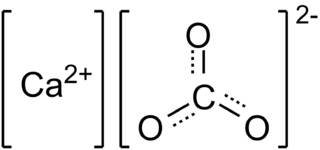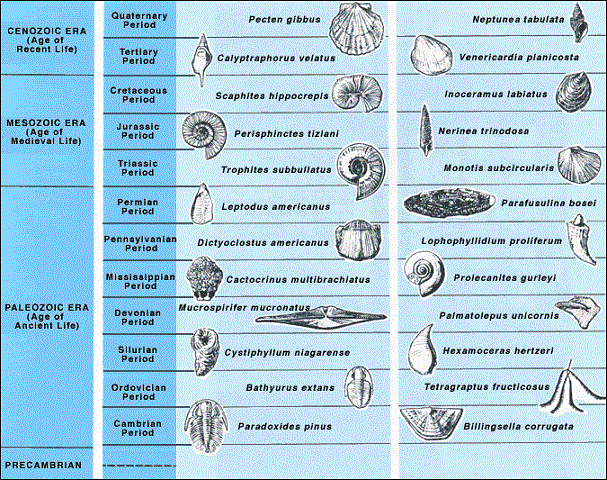
At the listed coordinates you will find an obelisk that represents the monument to Croatian national anthem. The monument is made of limestone, or to be more precise of type of limestone that is called lithothamnium limestone.
Limestone
Limestone is categorized as sedimentary rock. Sedimentary rocks are one of three large groups of rocks, the other two are igneous and metamorphic. Sedimentary rocks are formed when different materials are deposited by different geological processes and accumulated either at the surface of Earth or within water. Accumulated material that forms sedimentary rocks is called sediment. Limestone is sedimentary rock that is mainly (more than 50%) built from calcium carbonate (CaCO3), particularly from its two crystal forms - calcite and aragonite.
CaCO3
 Source: Wikipedia
Source: Wikipedia
Majority of limestone form in shallow, calm and warm marine waters. Limestone represents 10% of all sedimentary rocks. There are different types of limestone and they can be formed by various processes. In general, if limestone is formed from calcium carbonate that came from various marine organisms (e.g. corals, forams, molluscs) then it is called biological limestone. Its biological origins could often be detected by the presence of fossils. Limestone can also be formed by direct precipitation of minerals from water and such limestone is called chemical limestone.
Lithothamnium Limestone
Lithothamnium limestone is a type of limestone that contains numerous fossils of red algae, with the genus Lithothamnion being the most numerous among them. During the the Middle Miocene (15 million years ago) those algae lived in Paratethys ocean. Lithothamnium limestone was formed with the accumulation of algae fossils, together with fossils of other shallow sea, tropical organisms – molluscs, snails, sea urchins, corals, bryozoa and foraminifera. Those accumulated fossils over many years of accumulation were transformed into sedimentary rock limestone by binding initial organic material together with chemically precipitated calcium carbonate cement.
Fossils
Fossils are accidental by-products of life preserved in the geological record. They can be formed in all sorts of ways by the processes of nature. Life comes in a wide variety of forms and shapes and so therefore do fossils. Since each life-form can be fossilized in several different ways the variety found in fossils is amazing. Some fossils are used as index fossils and they are used to define and identify geologic periods of different sediments. Index fossils are also called guide fossils, indicator fossils or zone fossils.
Index Fossils
 Source: United States Geological Survey (usgs.gov)
Source: United States Geological Survey (usgs.gov)
Fossils are anything that provides evidence of life in past ages. That evidence of life in past ages can come in two general types. It can be either direct evidence or indirect evidence of past life.
Direct evidence of life are fossils of hard body parts of organisms. They can be fossilized bones or shells in case of animals. Or it can be fossilized wood or leaves in case of plants. In some cases, the entire organism can be fossilized, together with both soft and hard parts. Example of such fossils are insects trapped in amber or mammoths frozen in ice.
Indirect evidence of life are trace fossils. They are various footprints, trails, marks that were left by organisms and then fossilized. Coprolites (fossilized poo) is also one example of trace fossils. Another example of trace fossils are chemical fossils that represent organic compounds that survive in the form of oil, gas or bitumen.
Logging Tasks
To log this EarthCache answer the following questions:
1. Observe the obelisk and describe color and texture of lithothamnium limestone.
2. Search the obelisk and find at least one fossil. Describe the fossil and report its measures.
3. Based on your observation of fossil, what do you think: is this fossil direct evidence or indirect evidence of past life? Why?
4. Based on your observations, do you think this limestone is biological or chemical limestone? Why?
Send your answers through my profile at geocaching.com (through e-mail or message center) and NOT in a log. You don't have to wait for me to approve your answers. Once you send your answers feel free to log this EarthCache as found. If there are problems with your answers, I will contact you.
Sources
1. Fossils, Course Notes, EarthCache Academy.
2. Alecia M. Spooner, Geology for Dummies, Hoboken: Wiley Publishing, Inc., 2011.
3. Monica Price and Kevin Walsh, Rocks and Minerals, London: Dorling Kindersley, 2005.
4. Cyril Walker and David Ward, Fossils, London: Dorling Kindersley, 2000.
5. Geoloske zanimljivosti Krapinsko-zagorske zupanije, Krapina: Krapinsko-zagorska zupanija, 2011.
6. Wikipedia.org

Na izlistanim koordinatama pronaći ćete obelisk koji predstavlja spomenik hrvatskoj himni. Spomenik je izrađen od vapnenca ili preciznije od vrste vapnenca koji se naziva litotamnijski vapnenac.
Vapnenac
Vapnenac se kategorizira kao sedimentna stijena. Sedimentne stijene su jedna od tri velike skupine stijena. Druge dvije skupine su magmatske i metamorfne stijene. Sedimentne stijene nastaju kada se različiti materijali talože različitim geološkim procesima. Navedeni materijali se akumuliraju ili na površini Zemlje ili u vodi. Akumulirani materijal od kojega se stvaraju sedimentne stijene naziva se sediment. Vapnenac je sedimentna stijena koja je uglavnom (vise od 50%) građena od kalcijevog karbonata (CaCO3) i to konkretno od njegova dva kristalna oblika - kalcita i aragonita.
CaCO3
 Izvor: Wikipedia
Izvor: Wikipedia
Većina vapnenačkih stijena nastaje u plitkim, mirnim i toplim morima. Vapnenac cini oko 10% svih sedimentnih stijena. Postoje različite vrste vapnenaca koji mogu nastati različitim procesima. Općenito, ako je vapnenac nastao od kalcijevog karbonata koji potječe od različitih morskih organizama (npr. koralja, krednjaka, mekušaca) tada se takav vapnenac naziva biološki vapnenac. Biološko porijeklo takvog vapnenca se često može detektirati na temelju prisutnosti fosila. Vapnenac također može nastati direktnim taloženjem minerala iz vode. Takav vapnenac se naziva kemijski vapnenac.
Litotamnijski vapnenac
Litotamnijski vapnenac je tip vapnenca koji sadrži mnogobrojne fosilne ostatke crvenih algi, među kojima je najbrojniji rod Lithothamnion. Te su alge tijekom srednjeg miocena (prije petnaestak milijuna godina) živjele u tadašnjem Paratethys oceanu. Nakupljanjem fosilnih ostataka algi, zajedno s fosilnim ostacima ostalih plitkomorskih tropskih organizama poput školjkaša, puževa, ježinaca, koralja, mahovnjaka i foraminifera, nastali su litotamnijski vapnenci. Tijekom mnogih godina ovi su se nakupljeni fosili transformirali u sedimentnu stijenu vapnenca povezujući inicijalni organski materijal zajedno s kemijski taloženim cementom kalcijevog karbonata.
Fosili
Fosili su slučajni nusproizvodi života očuvani u geološkom materijalu. Fosili mogu nastati na različite načine pomoću prirodnih procesa. Život se javlja u raznim oblicima, pa se stoga i fosili javljaju u različitima oblicima. S obzirom da se svaki oblik života može fosilizirati na nekoliko načina, među fosilima postoji nevjerojatna raznolikost. Neki fosili se koriste kao indeksni fosili, te se pritom koriste za definiranje i identificiranje geoloških razdoblja različitih sedimenata. Indeksni fosili se još nazivaju i indikatorski fosili ili zonski fosili.
Indeksni fosili
 Izvor: United States Geological Survey (usgs.gov)
Izvor: United States Geological Survey (usgs.gov)
Fosili su sve ono što dokazuje život u prošlim vremenima. Taj se dokaz prošlog života javlja u dva oblika. On može biti izravan ili neizravan.
Izravan dokaz života su fosili koje čine čvrsti dijelovi organizama. U slučaju životinja, to mogu biti fosilizirane kosti ili školjke. Ili, kada su u pitanju biljke, to može biti fosilizirano drvo ili lišće. U nekim slučajevima, fosiliziran može biti i cijeli organizam, i njegovi meki i njegovi čvrsti dijelovi. Primjeri takvih fosila su insekti zarobljeni u jantaru ili mamuti smrznuti u ledu.
Neizravan dokaz života su fosilni tragovi. To su različiti otisci stopala, repova, tragova, koje su organizmi ostavljali, a zatim su fosilizirani. Koproliti (fosilizirana kakica) su također jedan primjer fosilnih tragova. Još jedan primjer fosilnih tragova predstavljaju i kemijski fosili. Kemijski fosili su organski spojevi koji su se očuvali u obliku nafte, plina ili bitumena.
Zadaci za logiranje
Kako biste logirali ovaj EarthCache odgovorite na sljedeća pitanja:
1. Promotrite obelisk i opišite boju i teksturu litotamnijskog vapnenca.
2. Pretražite obelisk i pronađite bar jedan fosil. Opišite pronađeni fosil i izvjestite o njegovim mjerama.
3. Na temelju promatranja pronađenog fosila, što mislite: je li ovaj fosil izravan ili neizravan dokaz o prošlom životu? Zašto?
4. Na temelju uočenog, je li ovaj vapnenac biološki ili kemijski vapnenac? Zašto?
Odgovore pošaljite preko mog profila na geocaching.com, a NE u Vašem logu! Ne morate čekati na moje potvrđivanje Vaših odgovora. Jednom kada pošaljete Vaše odgovore slobodno logirajte pronalazak ovog EarthCachea. Ako Vaši odgovori budu pogrešni ja ću kontaktirati Vas.
Izvori
1. Fossils, Course Notes, EarthCache Academy.
2. Alecia M. Spooner, Geology for Dummies, Hoboken: Wiley Publishing, Inc., 2011.
3. Monica Price and Kevin Walsh, Rocks and Minerals, London: Dorling Kindersley, 2005.
4. Cyril Walker and David Ward, Fossils, London: Dorling Kindersley, 2000.
5. Geološke zanimljivosti Krapinsko-zagorske županije, Krapina: Krapinsko-zagorska županija, 2011.
6. Wikipedia.org